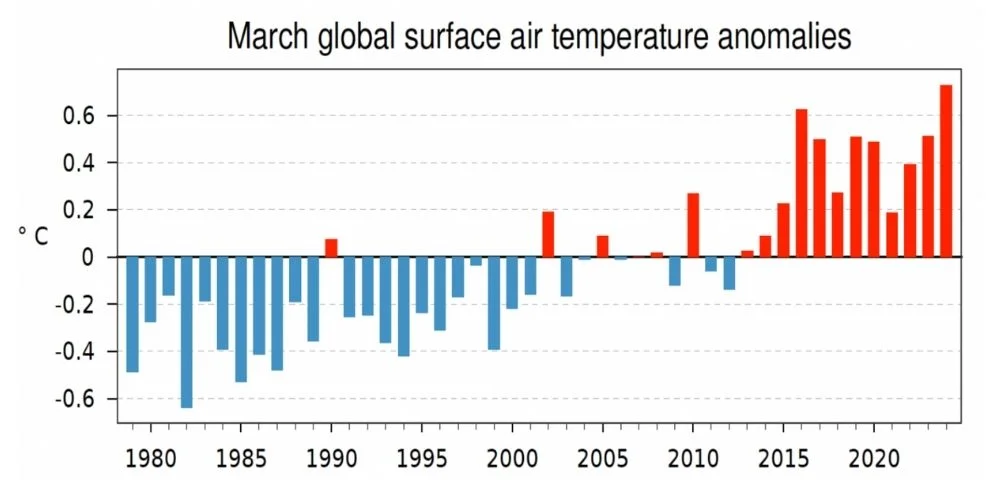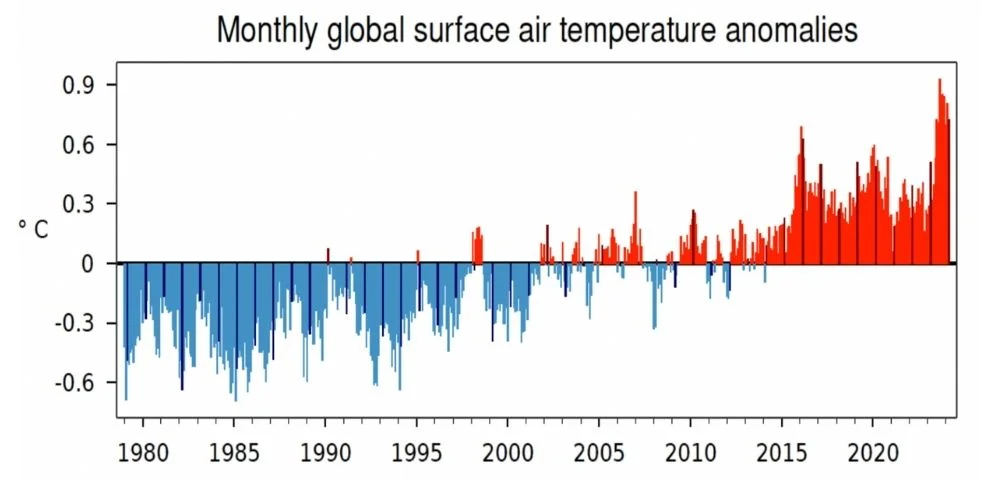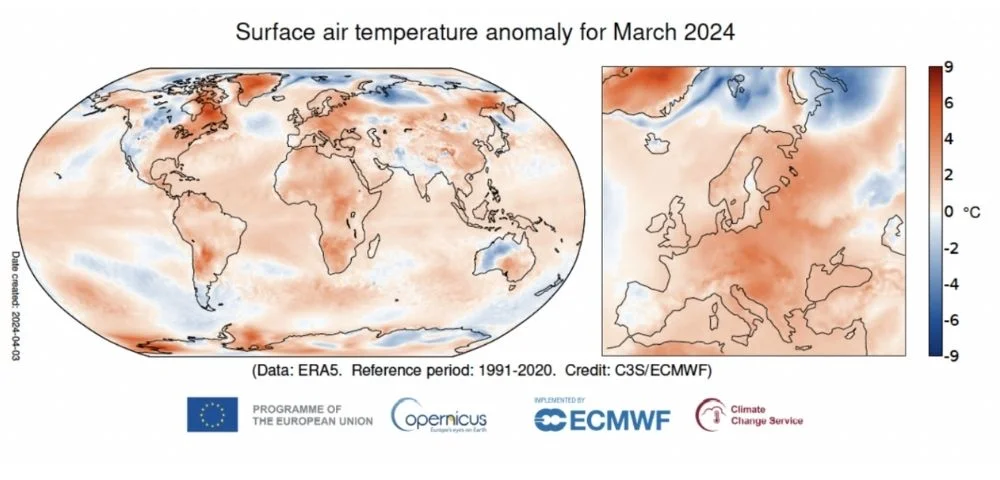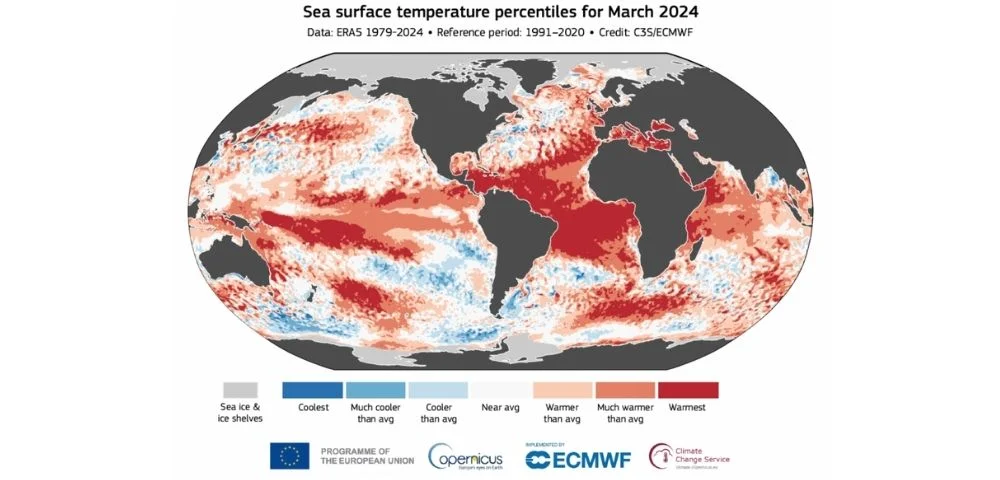The Warmest Year on Record
As in previous months, March 2024 witnessed an unprecedented global surface air temperature anomaly, surpassing historical records.
Averaging 14.14°C, it exceeded the 1991-2020 baseline by 0.73°C, marking the tenth consecutive month of record-breaking warmth. The preceding twelve months also registered the highest global average temperature ever recorded. Consequently, the period spanning 2023-2024 now stands as the warmest year on record, surpassing the previous benchmark set in March 2016 by 0.10°C. Europe experienced its second warmest March, indicative of a broader warming trend. Despite a weakening El Niño, marine temperatures remained significantly elevated. These findings underscore the imperative for proactive measures to mitigate climate change.
Historical March Temperatures

March 2024 was warmer globally than any previous March in the data record, with an average ERA5 surface air temperature of 14.14°C, 0.73°C above the 1991-2020 average for March and 0.10°C above the previous high set in March 2016. This is the tenth month in a row that is the warmest on record for the respective month of the year.

The month was 1.68°C warmer than an estimate of the March average for 1850-1900, the designated pre-industrial reference period.
The global-average temperature for the past twelve months (April 2023 – March 2024) is the highest on record, at 0.70°C above the 1991-2020 average and 1.58°C above the 1850-1900 pre-industrial average.
Regional Findings
The average European temperature for March 2024 was 2.12°C above the 1991-2020 average for March, making the month the second warmest March on record for the continent, only a marginal 0.02°C cooler than March 2014.
Temperatures were most above average in central and eastern regions.

Outside Europe, temperatures were most above average over eastern North America, Greenland, eastern Russia, Central America, parts of South America, many parts of Africa, southern Australia and parts of Antarctica.
The El Niño continued to weaken in the eastern equatorial Pacific, but marine air temperatures in general remained at an unusually high level.
The global sea surface temperature averaged for March over 60°S–60°N was 21.07°C, the highest monthly value on record, marginally above the 21.06°C recorded for February.
Germany reported its warmest March since measurements began in 1881.
The Netherlands likewise reported its warmest March in a record dating from 1901, with no frost day experienced for only the second time.
Austria recorded its warmest March at lowland stations, though not at altitude. Late in the month, many countries further to the east, including Croatia, Latvia and Moldova, saw national records for high March temperatures being equalled or exceeded.
Temperatures were especially high over Central America (where drought continues to reduce shipping through the Panama Canal)and parts of South America, particularly over Venezuela and a central region of the continent.
Many parts of Africa also experienced exceptionally high temperatures.
South Australia had its warmest March on record.
Antarctic temperatures were relatively high over Marie Byrd Land and east of the Antarctic Peninsula.
Land regions with notably below-average temperatures include western Siberia, the western USA and central Canada, rain-affected western and northern Australia, southern Chile and Argentina, and parts of Antarctica.
Air temperatures were above average over large parts of the ocean, although El Niño conditions continued to weaken over the eastern equatorial Pacific.
Sea Surface Temperature Anomalies for March 2024

Fig. 5. Sea surface temperature percentiles for March 2024. Color categories refer to the percentiles of the temperature distributions for the 1991–2020 reference period. The extreme (“Coolest” and “Warmest”) categories refer to the period 1979–2024. Values are calculated only for the ice-free oceans. Areas covered with sea ice and ice shelves in March 2024 are shown in light grey. Data source: ERA5. Credit: Copernicus Climate Change Service/ECMWF
Temperatures were below average over several mainly small areas of the world’s ocean, most extensively over much of the ice-covered Arctic Ocean, and in the Southern Hemisphere to the south and west of Chile and in a band from Antarctica to New Zealand.
The high marine air temperatures were associated with continuing record sea-surface temperatures (SSTs). The daily SST averaged over 60°S–60°N (see our Climate Pulse web app) continued in March 2024 at or just a few hundredths of a degree below the new absolute high of 21.09°C reached at the end of February.
Although the current El Niño event has been an important contributor to the high global SSTs observed over the past months, SSTs in the eastern equatorial Pacific fell below the 1991-2020 average in places during March. SSTs were nevertheless the highest on record over a sizeable part of the tropical western Pacific. Moreover, high SSTs in ocean regions outside of the equatorial Pacific are a key contributor to the current global SST records.
There is general agreement among datasets that the period since 2015 is much warmer globally than any previous period.
There is also agreement that global temperature has risen at an average rate close to 0.2°C per decade since the late 1970s.























